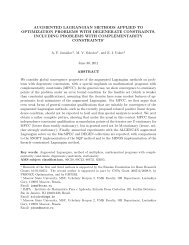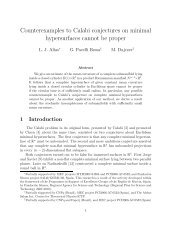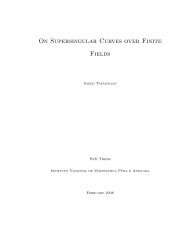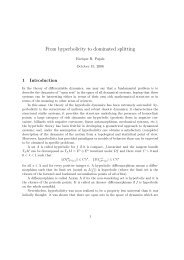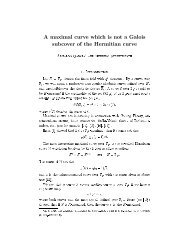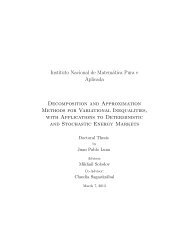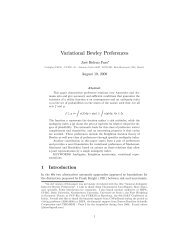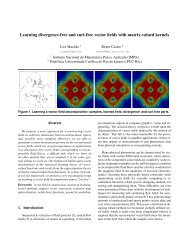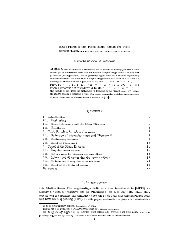a reduced model for internal waves interacting with submarine ...
a reduced model for internal waves interacting with submarine ...
a reduced model for internal waves interacting with submarine ...
You also want an ePaper? Increase the reach of your titles
YUMPU automatically turns print PDFs into web optimized ePapers that Google loves.
inary axis (where the eigenvalues of the linearized spatial discretization operators<br />
lie), RK4 is less restrictive, allowing larger time steps and numerical evolution<br />
over longer time intervals, as we will see in the experiments below. For a better<br />
visualization, in Fig. 4.2 we compute the amplification factor|R(z)| where z=λ∆t<br />
andλrepresents the largest (in the sense of absolute value) eigenvalue of the linearized<br />
spatial discretization operator, see <strong>for</strong> example [2]. The AM3 scheme<br />
has the smallest stability interval along the imaginary axis since the amplification<br />
factor becomes greater than one very quickly. This implies a more restrictive<br />
stability condition when using the AM3 scheme to solve the bidirectional wave<br />
equation, <strong>for</strong> example. However, <strong>for</strong> the regularized dispersive systems considered<br />
here, we obtained less instability since the phase velocity actually decreases<br />
as the wavenumber grows accommodating high wave-numbers better than in the<br />
hyperbolic case (see the dispersion relation in Section 2.3). Dispersion comes in<br />
as a physical regularization in comparison <strong>with</strong> its underlying hyperbolic counterpart.<br />
Still, the classical fourth order Runge-Kutta seems to be the best choice.<br />
The spectral approximation of theξ-derivative is more accurate than the five<br />
point <strong>for</strong>mula exhibited above. However, we cannot use numerical velocity one<br />
(∆t = ∆ξ) <strong>with</strong> it, in correspondence <strong>with</strong> the theoretical velocity, because of<br />
stability restrictions of the method of lines already discussed. The reason <strong>for</strong><br />
choosing the Courant number as one is to avoid a numerical delay of the travelling<br />
wave speed that could interfere <strong>with</strong> the expected delay that may result from the<br />
interaction of the wave <strong>with</strong> a rapidly-varying bottom profile. This particular issue<br />
will be investigated in the near future. For the time being, we choose the five point<br />
<strong>for</strong>mula (4.5) in all the numerical experiments presented in this chapter.<br />
The time domain is discretized as t n = n∆t, n=0,...,T final <strong>with</strong>∆t=∆ξ.<br />
58



